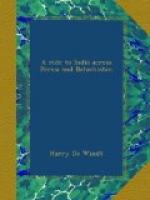The Russians may, according to English ideas, be uncivilized in many ways, but they are undoubtedly far ahead of other European nations, with the exception perhaps of France, as regards railway travelling. Although the speed is slow, nothing is left undone, on the most isolated lines, to ensure comfort, not to say luxury. Even in this remote district the refreshment-rooms were far above the average in England. At Akstafa, for instance, a station surrounded by a howling wilderness of steppe and marsh; well-cooked viands, game, pastry, and other delicacies, gladdened the eye, instead of the fly-blown buns and petrified sandwiches only too familiar to the English railway traveller. The best railway buffet I have ever seen is at Tiumen, the terminus of the Oural railway, and actually in Siberia.
Railway travelling has, however, one drawback in this part of Russia, which, though it does not upset the arrangements of a casual traveller, must seriously inconvenience the natives—the distance of stations from towns. We drank tea, a couple of hours or so before arriving at Baku, at a station situated more than one hundred versts [E] from the town of its name. The inhabitants of the latter seldom availed themselves of the railway, but found it easier, except in very bad weather, to drive or ride to the Caspian port.
The dull wintry day wears slowly away, as we crawl along past league upon league of wild steppe land. The coup d’oeil from our carriage-window is not inspiriting. It rests upon a bare, bleak landscape, rolling away to the horizon, of waves of drab and dirty-green land, unbroken save for here and there a pool of stagnant water, rotting in a fringe of sedge and rush, or an occasional flock of wild-fowl. At rare intervals we pass, close to the line, a Tartar encampment. Half a dozen dirty brown tents surrounded by horses, camels, and thin shivering cattle, the latter covered with coarse sack-clothing tied round their bellies to protect them from the cutting blast that sweeps from the coast across this land of desolation. None of the human population are visible, and no wonder. It must be cold enough outside. Even in this well-warmed compartment one can barely keep feet and fingers from getting numbed.
It is almost dark when, towards six o’clock, there appears, far ahead, a thin streak of silver, separating the dreary brown landscape from the cold grey sky.
“We have nearly arrived, monsieur,” says Gerome. “There is the Caspian Sea.”
[Footnote A: The sacred image of the Saviour or Holy Virgin.]
[Footnote B: The name Tiflis is derived from Tbilis Kalaki, or “Hot Town,” so called from the hot mineral springs near which it stands.]
[Footnote C: Bourka, a long sleeveless coat made of goatskin.]
[Footnote D: Bashlik, the soft camel-hair hood and neckerchief in one, worn by Russian soldiers.]
[Footnote E: A verst is about three-quarters of a mile.]




